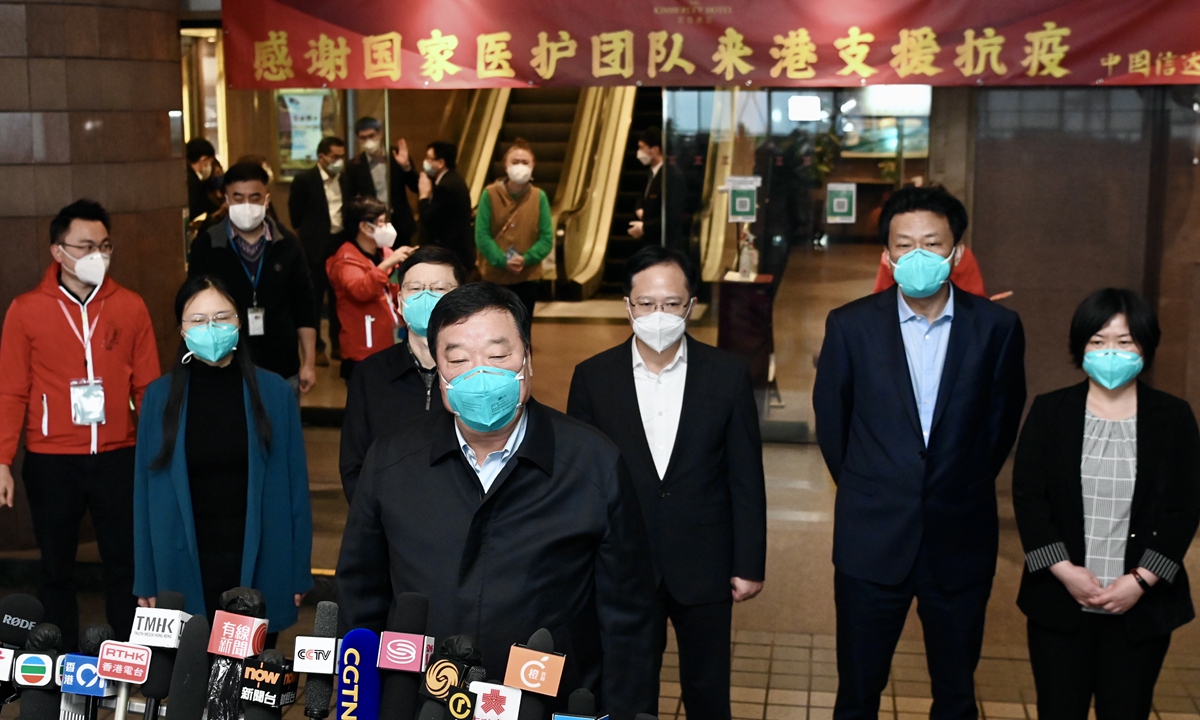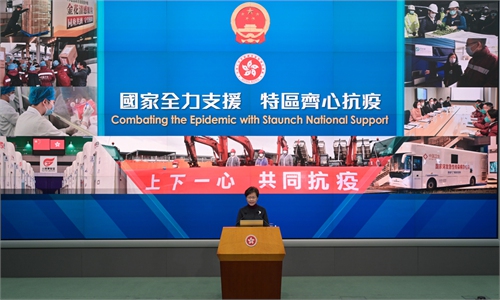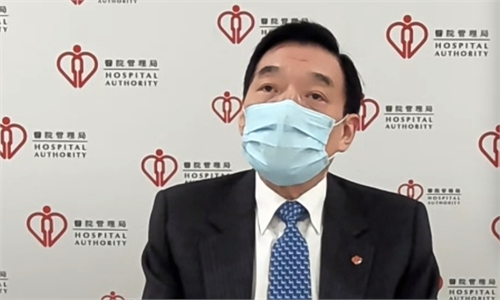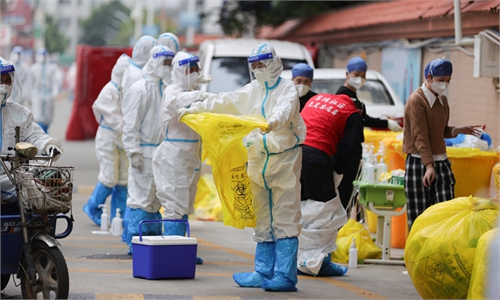Top-level mainland experts arrive to support Hong Kong, boosting Chief Executive's confidence in fighting against virus

A five-member expert team, the third batch and the highest-level expert team so far dispatched by the Chinese central government, arrive in Hong Kong on February 28, 2022. Photo: VCG
The Chief Executive of Hong Kong Carrie Lam on Monday said that the city would certainly win the battle against the COVID-19 with the support of the Chinese mainland, following the arrival of a five-member expert team, the third batch and the highest-level expert team so far dispatched by the central government, on the same day.
"We will work against the clock to work with and communicate with Hong Kong experts to ensure the current anti-epidemic measures are effective, and ensure the health and lives of Hong Kong residents," Liang Wannian, head of the central government's experts team, said upon arriving in Hong Kong on Monday.
Liang's arrival, as part of the third batch of expert teams dispatched by the central government, is expected to bring more advice to the Hong Kong government and experts in the city on how the mainland cities has coped with mounting infections with dynamic zero-case measures.
Speaking in a virtual speech, Lam gave thanks for the continuous support of the central government, including helping Hong Kong build makeshift hospitals and providing materials.
With the strong backbone of the central government, Lam said that Hong Kong is certain to get over the outbreak and win the battle against the novel coronavirus, letting residents return to normal life as soon as possible.
Lam also announced the city's latest move to combat the epidemic - mandatory mass testing in March, noting that a detailed plan is under discussion.
The next two to three months would be vital for the city. Those who tested positive in the mass testing would be sent into quarantine according to their specific conditions, according to Lam.
Hong Kong reported 32,359 confirmed cases on Sunday, bringing the total to surpass 170,000, about 57 percent higher than the cumulative infections reported in the Chinese mainland.
The total death toll in the fifth wave of the outbreak reached 636, after another 87 deaths were reported on Sunday.
The city is building four makeshift hospitals and some community quarantine facilities to tackle the problem of a lack of beds in the face of the roaring epidemic. More than 70,000 patient beds will be available after these facilities are completed, according to Lam.
The first makeshift facility in Tsing Yi, built with aid from the mainland, was delivered on Monday.
Five other temporary community quarantine facilities - including one in the Hong Kong-Zhuhai-Macao Bridge's Hong Kong Port - have all completed site preparation work, and the overall progress is smooth, the Global Times learned from the China State Construction Engineering Corp on Monday.
Hong Kong continues to report record high cases and is approaching the date of mass testing in order to have a thorough screening out of potential infections across the city, experts said.
Lu Hongzhou, head of the Third People's Hospital of Shenzhen, told the Global Times on Monday that the arrival of Liang will bring more practical advice on how Hong Kong can efficiently implement the dynamic zero-case policy as the city scrambles to contain rising infections.
Because of social differences, the dynamic zero-case policy cannot be completely replicated in Hong Kong, but the basic rule - which is to detect all potential infections and quarantine them - remains unchanged.
Xia Baolong, head of the Hong Kong and Macao Affairs Office of the State Council, said at the sixth coordination meeting on Sunday that the central government will ramp up efforts to aid Hong Kong, and also promised to offer any medical or living materials that Hong Kong needs.
The central government has already organized nucleic acid testing teams composed of about 9,000 people ready to facilitate mass testing in Hong Kong, and they can depart for the city at any time when Hong Kong needs them, Li Dachuan, an official from the National Health Commission, said on Sunday in an interview with Hong Kong media.
If necessary, the Hong Kong government can also send samples to Guangdong Province, which is able to test 1.2-1.5 million samples per day, much more than the 300,000 samples per day Hong Kong can deal with, Li said.
Yin Weidong, CEO of Chinese vaccine producer Sinovac, told the Global Times on Monday that Sinovac has also been supporting Hong Kong in terms of vaccine research and development, the supplies of vaccines and more input in protection of seniors and minors. "Ensuring vaccine supply is our top commitment to Hong Kong," Yin said.
While Hong Kong is being hit hard by the Omicron variant, the bordering Guangdong is also feeling the pressure as it is playing a role in providing supplies to Hong Kong to combat the virus.
Meanwhile, it should prevent the epidemic from spilling over to the city.
Imported cases have been frequently reported in cities across Guangdong with 31 confirmed cases reported in Shenzhen, six in Zhuhai, two in Huizhou, and one each in Shanwei, Dongguan, Zhongshan and Jiangmen, the Guangdong provincial health commission said on Monday.
For Shenzhen, ports are pressured with receiving cross-border drivers who ensure epidemic supplies for Hong Kong, while local communities are also at risk of having sporadic outbreaks caused by drivers and stowaways from the city, Lu said.
Once a COVID-19 patient is detected, Shenzhen authorities will do contact tracing to cut off the transmission chain. Despite the huge pressure, Shenzhen is capable of handling imported cases from Hong Kong as long as "we stick to dynamic zero-case policy," Lu noted.
Shenzhen has adopted measures to address the huge challenge brought by the Hong Kong epidemic, including requiring cross-border drivers to undergo dual testing when crossing the border starting from Tuesday.
Those who are allowed to enter will be issued with a yellow health code and put under closed-loop management, and banned from entering local communities and public venues. Those who test positive are prohibited from entering the Chinese mainland border in the next 21 days, the new measure said.



